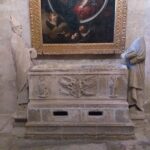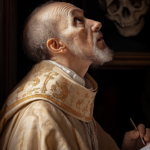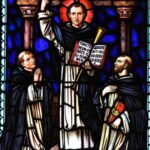St. Alphonsus Rodriguez
Saint Alphonsus Rodriguez
St. Alphonsus Rodriguez
When he lived:
St. Alphonsus Rodriguez lived from 1532 to 1617, during the captivating era of the Renaissance and the Age of Exploration.
Where he lived:
St. Alphonsus Rodriguez resided in the vibrant city of Segovia, Spain. Nestled among the rolling hills of the Castile and León region, Segovia was renowned for its architectural marvels, including the majestic Alcázar and the awe-inspiring Roman aqueduct.
Notable world events during the time of his life:
- Magellan’s Circumnavigation (1519-1522):During St. Alphonsus Rodriguez’s early years, Ferdinand Magellan embarked on an unprecedented expedition to circumnavigate the globe. This remarkable feat marked the first documented circumnavigation of the Earth and expanded humanity’s understanding of the world’s vastness.
- The Council of Trent (1545-1563):As St. Alphonsus Rodriguez matured, the Council of Trent convened. This momentous event in Catholic history addressed the pressing issues of the Protestant Reformation, sought to reassert Catholic doctrine, and paved the way for significant reforms within the Church.
- Copernican Revolution (1543):In 1543, Nicolaus Copernicus revolutionized the world of astronomy with the publication of his seminal work, “De revolutionibus orbium coelestium” (“On the Revolutions of the Celestial Spheres”). This groundbreaking theory presented the heliocentric model, challenging the prevailing geocentric worldview and sparking a scientific revolution.
- Spanish Armada (1588):The year 1588 witnessed the dramatic clash between the Spanish Armada, under the command of King Philip II of Spain, and the English fleet led by Queen Elizabeth I. The defeat of the Spanish Armada marked a significant turning point in European history, solidifying England’s naval dominance and shaping the course of political and religious power.
- Publication of the King James Bible (1611):Towards the end of St. Alphonsus Rodriguez’s life, the King James Bible, also known as the Authorized Version, was published in England. This influential translation of the Bible into English not only had a profound impact on religious practices but also played a vital role in shaping the English language and literature.
His patronage:
St. Alphonsus Rodriguez is widely recognized as the patron saint of several diverse groups and occupations. Among his patronages, he is particularly revered as the patron saint of students, educators, and schools. His steadfast devotion to education and his role as a doorkeeper at the Jesuit College in Palma, Mallorca, inspired a lasting association with learning and academia. Additionally, St. Alphonsus Rodriguez is also regarded as the patron saint of the humble and of those seeking employment, offering solace and guidance to those in need of work and a humble spirit.
Early Life
Saint Alphonsus Rodriguez was born in Segovia, Spain, on July 25, 1532. He was the second son born to a distinguished wool merchant.
During the time that one of the Jesuit pioneers, Peter Faber, visited Spain on mission work, Alphonsus’ family welcomed him into their home. As a possible result, Peter Faber helped the young Alphonsus through his very first communion.
Saint Alphonsus lost his father at the age of 14. A formerly comfortable family, they soon began to struggle, causing Alphonsus to join his mom in selling wool and clothing materials.
Soon, his mother retired, and he began controlling the business. Around the age of 26 or 27, Saint Alphonsus got married to Mara Suarez. They were a very happy and content couple, and we were blessed with three kids.
Unfortunately, tragedy struck. Saint Alphonsus lost his wife and two of his children at the age of 31. The business started to fall apart, and soon his only surviving child passed away too.
These events drove him to pay more attention to his spiritual life. He not only prayed and fasted but also practiced mortification of the flesh.
Dedication and devotion
This continued for years, until he was at peace with himself. He continued to hunger for more and aimed to go into the priesthood in Jesuit society. He, however, fell short due to his lack of proper education and his rapidly failing health.
Finally, at the age of 40, on January 31, 1571, Saint Alphonsus was admitted to the Jesuit society. He was given a provisional allowance as a layman in society.
At this time, novitiates for lay brothers had not been founded in Spain. Due to this, he was sent to Valencia or Gandia. Where exactly he was is always up for debate among historians.
Saint Alphonsus was sent to a recently established college in Majorca. He was steadfast in completing his novitiate.
In Majorca, Saint Alphonsus was friendly and lived a pious life. He was liked by everyone. He was assigned as the college’s doorkeeper.
Saint Alphonsus served for about 46 years. He was humble at his job and received visitors in the college politely, ran errands, and never complained.
Legacy
While working at that humble job, Saint Alphonsus met Peter Claver. They became very fast friends. Alphonso took his vows in 1585.
While Saint Alphonsus might have looked soft, he was rather strict with himself. He had practiced mortification of the flesh most of his life.
Some of these notifications were extreme and physical, but he carried on because he wanted to lose any temptation of the flesh. Though he was nothing but a lowly man, he was respected by his Jesuit brothers.
During special occasions, Saint Alphonsus was allowed to preach to the monks. He was such an eloquent speaker that everyone was always caught in the rapture of his speech.
Saint Alphonsus was devoted to the Virgin Mary. He was said to have spent hours reciting to her and praying to her.
Although strong in faith, Saint Alphonsus’ body continued to grow weaker. This was probably due to years of strict mortification.
Death and Canonization
Saint Alphonsus was loved for his piety until he died on October 31, 1617.
After his death, several of his writings were found. These writings were not in any way intended to be published but were for his meditation.
Saint Alphonsus was buried in Majorca, which was a pilgrimage site for many. He was canonized in September of the year 1888.
Saint Alphonsus is celebrated by the Catholic Church on the 31st of October, the day of his death. He is also remembered by the Society of Jesus until today.
5 Interesting Facts About St. Alphonsus Rodriguez
- Did you know that some traditions state that Saint Alphonsus
attended a Jesuit college at the age of 12? He could, however, not
complete his education due to his father’s death. - Did you know that some traditions state that while working as
doorkeeper, Saint Alphonsus, would imagine that God was at the door.
every time that the bell rang? - Did you know that Saint Alphonsus encouraged Peter Claver to take
the mission work in South America? - Did you know that a parish is dedicated to Saint Alphonsus? The
The church is located in Maryland. - Did you know that Saint Alphonsus Rodriguez is the patron saint of
the Jesuit Brothers?
Prayer to St. Alphonsus Rodriguez
O God, in the faithful service of our brother Alphonsus, you have shown us the way to joy and peace. Make us ready and watchful companions of Jesus, who became the servant of all and now lives and reigns with you and the Holy Spirit, one God, forever and ever. Amen.
Source:[https://www.catholicculture.org/culture/liturgicalyear/prayers/view.cfm?id=1446]{.ul}



